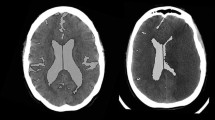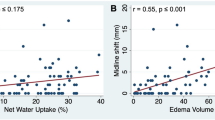Abstract
Background
Cerebral edema has primarily been studied using midline shift or clinical deterioration as end points, which only captures the severe and delayed manifestations of a process affecting many patients with stroke. Quantitative imaging biomarkers that measure edema severity across the entire spectrum could improve its early detection, as well as identify relevant mediators of this important stroke complication.
Methods
We applied an automated image analysis pipeline to measure the displacement of cerebrospinal fluid (ΔCSF) and the ratio of lesional versus contralateral hemispheric cerebrospinal fluid (CSF) volume (CSF ratio) in a cohort of 935 patients with hemispheric stroke with follow-up computed tomography scans taken a median of 26 h (interquartile range 24–31) after stroke onset. We determined diagnostic thresholds based on comparison to those without any visible edema. We modeled baseline clinical and radiographic variables against each edema biomarker and assessed how each biomarker was associated with stroke outcome (modified Rankin Scale at 90 days).
Results
The displacement of CSF and CSF ratio were correlated with midline shift (r = 0.52 and − 0.74, p < 0.0001) but exhibited broader ranges. A ΔCSF of greater than 14% or a CSF ratio below 0.90 identified those with visible edema: more than half of the patients with stroke met these criteria, compared with only 14% who had midline shift at 24 h. Predictors of edema across all biomarkers included a higher National Institutes of Health Stroke Scale score, a lower Alberta Stroke Program Early CT score, and lower baseline CSF volume. A history of hypertension and diabetes (but not acute hyperglycemia) predicted greater ΔCSF but not midline shift. Both ΔCSF and a lower CSF ratio were associated with worse outcome, adjusting for age, National Institutes of Health Stroke Scale score, and Alberta Stroke Program Early CT score (odds ratio 1.7, 95% confidence interval 1.3–2.2 per 21% ΔCSF).
Conclusions
Cerebral edema can be measured in a majority of patients with stroke on follow-up computed tomography using volumetric biomarkers evaluating CSF shifts, including in many without visible midline shift. Edema formation is influenced by clinical and radiographic stroke severity but also by chronic vascular risk factors and contributes to worse stroke outcomes.




Similar content being viewed by others
References
Simard JM, Kent TA, Chen M, Tarasov KV, Gerzanich V. Brain oedema in focal ischaemia: molecular pathophysiology and theoretical implications. Lancet Neurol. 2007;6:258–68.
Hacke W, Schwab S, Horn M, et al. “Malignant” middle cerebral artery territory infarction: clinical course and prognostic signs. Arch Neurol. 1996;53:309–15.
Battey TW, Karki M, Singhal AB, et al. Brain edema predicts outcome after nonlacunar ischemic stroke. Stroke. 2014;45(12):3643–8.
Dhar R. Automated quantitative assessment of cerebral edema after ischemic stroke using CSF volumetrics. Neurosci Lett. 2020;724:134879.
Kimberly WT, Battey TW, Wu O, et al. Novel imaging markers of ischemic cerebral edema and its association with neurological outcome. Acta Neurochir Suppl. 2016;121:223–6.
Strbian D, Meretoja A, Putaala J, Kaste M, Tatlisumak T. Cerebral edema in acute ischemic stroke patients treated with intravenous thrombolysis. Int J Stroke. 2013;8:529–34.
Kimberly WT, Dutra BG, Boers AMM, et al. Association of reperfusion with brain edema in patients with acute ischemic stroke: a secondary analysis of the MR CLEAN trial. JAMA Neurol. 2018;75(4):453–61.
Broocks G, Flottmann F, Scheibel A, et al. Quantitative lesion water uptake in acute stroke computed tomography is a predictor of malignant infarction. Stroke. 2018;49(8):1906–12.
Broocks G, Flottmann F, Hanning U, et al. Impact of endovascular recanalization on quantitative lesion water uptake in ischemic anterior circulation strokes. J Cereb Blood Flow Metab. 2019:271678X18823601.
Dhar R, Chen Y, Hamzehloo A, et al. Reduction in cerebrospinal fluid volume as an early quantitative biomarker of cerebral edema after ischemic stroke. Stroke. 2020;51(2):462–7.
Dhar R, Hamzehloo A, Kumar A, et al. Hemispheric CSF volume ratio quantifies progression and severity of cerebral edema after acute hemispheric stroke. J Cereb Blood Flow Metab. 2021:271678X211018210.
Dhar R, Yuan K, Kulik T, et al. CSF volumetric analysis for quantification of cerebral edema after hemispheric infarction. Neurocrit Care. 2016;24(3):420–7.
Dhar R, Chen Y, An H, Lee JM. Application of machine learning to automated analysis of cerebral edema in large cohorts of ischemic stroke patients. Front Neurol. 2018;9:687.
Heitsch L, Ibanez L, Carrera C, et al. Early neurological change after ischemic stroke is associated with 90-day outcome. Stroke. 2021;52(1):132–41.
von Elm E, Altman DG, Egger M, et al. Strengthening the Reporting of Observational Studies in Epidemiology (STROBE) statement: guidelines for reporting observational studies. BMJ. 2007;335(7624):806–8.
Adams HP, Bendixen BH, Kappelle LJ, et al. Classification of subtype of acute ischemic stroke. Definitions for use in a multicenter clinical trial. TOAST. Trial of Org 10172 in Acute Stroke Treatment. Stroke. 1993;24(1):35–41.
Janssen PM, Visser NA, Dorhout Mees SM, et al. Comparison of telephone and face-to-face assessment of the modified Rankin Scale. Cerebrovasc Dis. 2010;29(2):137–9.
Dhar R, Yuan K, Kulik T, et al. CSF volumetric analysis for quantification of cerebral edema after hemispheric infarction. Neurocrit Care. 2015.
Pexman JH, Barber PA, Hill MD, et al. Use of the Alberta Stroke Program Early CT Score (ASPECTS) for assessing CT scans in patients with acute stroke. AJNR Am J Neuroradiol. 2001;22:1534–42.
MacCallum C, Churilov L, Mitchell P, Dowling R, Yan B. Low Alberta Stroke Program Early CT score (ASPECTS) associated with malignant middle cerebral artery infarction. Cerebrovasc Dis. 2014;38(1):39–45.
Kumar A, Chen Y, Corbin A, et al. Automated measurement of net water uptake from baseline and follow-up CTs in patients with large vessel occlusion stroke. Front Neurol. 2022;13:898728.
Fiorelli M, Bastianello S, von Kummer R, et al. Hemorrhagic transformation within 36 hours of a cerebral infarct: relationships with early clinical deterioration and 3-month outcome in the European Cooperative Acute Stroke Study I (ECASS I) cohort. Stroke J Cereb Circ. 1999;30:2280–4.
López-Ratón M, Rodríguez-Álvarez MX, Cadarso-Suárez C, Gude-Sampedro F. OptimalCutpoints: an R package for selecting optimal cutpoints in diagnostic tests. J Stat Softw. 2014;61(8):1–36.
Khalid F, Healy BC, Dupuy SL, et al. Quantitative MRI analysis of cerebral lesions and atrophy in post-partum patients with multiple sclerosis. J Neurol Sci. 2018;392:94–9.
Liu L, Shih Y-CT, Strawderman RL, et al. Statistical analysis of zero-inflated nonnegative continuous data: a review. Stat Sci. 34(2):253–79, 27.
Benjamini Y, Hochberg Y. Controlling the false discovery rate—a practical and powerful approach to multiple testing. J R Stat Soc Ser B Stat Methodol. 1995;57(1):289–300.
Voss S, Schneider A, Huth C, et al. ENVINT-D-20-01309: Long-term exposure to air pollution, road traffic noise, residential greenness, and prevalent and incident metabolic syndrome: results from the population-based KORA F4/FF4 cohort in Augsburg, Germany. Environ Int. 2021;147:106364.
Minnerup J, Wersching H, Ringelstein EB, et al. Prediction of malignant middle cerebral artery infarction using computed tomography-based intracranial volume reserve measurements. Stroke. 2011;42:3403–9.
Kauw F, Bennink E, de Jong H, et al. Intracranial cerebrospinal fluid volume as a predictor of malignant middle cerebral artery infarction. Stroke. 2019:STROKEAHA119024882.
Foroushani HM, Hamzehloo A, Kumar A, et al. Quantitative serial CT imaging-derived features improve prediction of malignant cerebral edema after ischemic stroke. Neurocrit Care. 2020;33:785–92.
Cannarsa GJ, Wessell AP, Chryssikos T, et al. Initial stress hyperglycemia is associated with malignant cerebral edema, hemorrhage, and poor functional outcome after mechanical thrombectomy. Neurosurgery. 2021;90(1):66–71.
Berger L, Hakim AM. The association of hyperglycemia with cerebral edema in stroke. Stroke. 1986;17(5):865–71.
Broocks G, Kemmling A, Aberle J, et al. Ischemic lesion water uptake in acute stroke: is blood glucose related to cause and effect? J Stroke. 2019;21(3):347–9.
Foroushani HM, Hamzehloo A, Kumar A, et al. Accelerating Prediction of malignant cerebral edema after ischemic stroke with automated image analysis and explainable neural networks. Neurocrit Care. 2021;36:471–82.
McKeown ME, Prasad A, Kobsa J, et al. Midline shift greater than 3mm independently predicts outcome after ischemic stroke. Neurocrit Care. 2021;25:1–6.
Broocks G, Kemmling A, Meyer L, et al. Computed tomography angiography collateral profile is directly linked to early edema progression rate in acute ischemic stroke. Stroke. 2019;50(12):3424–30.
Ng FC, Yassi N, Sharma G, et al. Cerebral edema in patients with large hemispheric infarct undergoing reperfusion treatment: a HERMES meta-analysis. Stroke 2021:STROKEAHA120033246.
Irvine HJ, Ostwaldt AC, Bevers MB, et al. Reperfusion after ischemic stroke is associated with reduced brain edema. J Cereb Blood Flow Metab. 2018;38(10):1807–17.
van Kranendonk KR, Treurniet KM, Boers AMM, et al. Added prognostic value of hemorrhagic transformation quantification in patients with acute ischemic stroke. Front Neurol. 2020;11:582767.
Vorasayan P, Bevers MB, Beslow LA, et al. Intravenous glibenclamide reduces lesional water uptake in large hemispheric infarction. Stroke. 2019:STROKEAHA119026036.
Author information
Authors and Affiliations
Contributions
RD and JML conceived of the study. QB carried out the primary analyses. Data were collected by AH, AK, YC, and LH. Additional data were provided and reviewed by AS and DS. RD and QB drafted the manuscript, tables, and figures. All authors reviewed and edited the manuscript and approved the final version.
Corresponding author
Ethics declarations
Conflicts of interest
JML reports grants from Biogen and personal fees from Regenera outside the submitted work. RD reports consulting fees from Marinus Pharma.
Ethical Approval/Informed Consent
All research was conducted under approval of the institutional ethics review board, and all study participants provided informed consent for data collection.
Additional information
Publisher's Note
Springer Nature remains neutral with regard to jurisdictional claims in published maps and institutional affiliations.
Supplementary Information
Below is the link to the electronic supplementary material.
Rights and permissions
Springer Nature or its licensor (e.g. a society or other partner) holds exclusive rights to this article under a publishing agreement with the author(s) or other rightsholder(s); author self-archiving of the accepted manuscript version of this article is solely governed by the terms of such publishing agreement and applicable law.
About this article
Cite this article
Bui, Q., Kumar, A., Chen, Y. et al. CSF-Based Volumetric Imaging Biomarkers Highlight Incidence and Risk Factors for Cerebral Edema After Ischemic Stroke. Neurocrit Care 40, 303–313 (2024). https://doi.org/10.1007/s12028-023-01742-0
Received:
Accepted:
Published:
Issue Date:
DOI: https://doi.org/10.1007/s12028-023-01742-0




